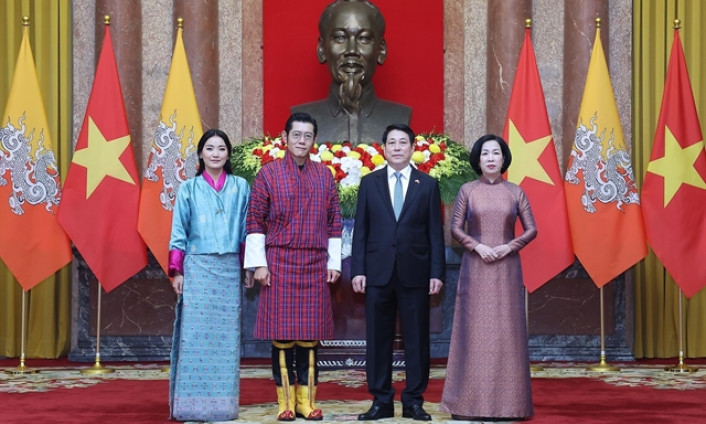International Women’s Day celebrations highlight gender disparities
Every year on International Women’s Day, Thu Hang’s office provides its female staff with a photo shoot, a VND500,000 (US$20) bonus, and a banquet…but she feels no joy.
"This is just surface-level gender equality," says Hang, a 33-year-old who works for a state-owned company in Hanoi.
She points to enduring disparities at her job, particularly evident in the responsibilities assigned to women. Notably, women bear the brunt of organizing and tidying up after the March 8 celebration. For Hang and the only other woman in their department, which has 10 men, the workload intensifies on this day, making it more taxing than usual.
Additionally, Hang and her colleague routinely handle numerous informal duties. Their daily tasks include making tea for a dozen people and documenting the minutes at meetings.
"We’re burdened with these informal office duties, akin to those at home," Hang said, expressing frustration. "They’re time-intensive, uncompensated, and undervalued."
Hang sought a transfer from administrative to project roles two years ago, aiming to broaden her skills. However, she was encouraged by her supervisors to remain in administration to "have time to take care of husband and children," she said.
Like clockwork, residents of Bich Ngoc’s apartment block in Ha Dong district, Hanoi began planning a March 8 banquet early. It’s seen as a chance for men to honor their wives and mothers.
Ngoc, 43, views the celebration as a community-building event, despite observing that women tend to shy away from eating much at the banquet and men consume more alcohol.
She also noted the irony of men who are typically uninvolved in household chores eagerly joining these events. For example, she mentions one 40-year-old man with two young children who relies on his wife and in-laws for all home tasks every day. But during women’s day celebrations, he loudly praises women’s excellence in "earning, birthing, and homemaking," and even offers to wash dishes.
"He washes dishes twice a year (including Vietnam Women’s Day October 20) and he believes that equates to equality," remarks Ngoc.
Vietnam has shown notable progress in gender equality, climbing 11 spots to rank 72nd out of 146 countries in the 2023 global gender gap index created by the World Economic Forum. This index, which ranges from 0 to 100, reflects the extent of gender parity and indicates Vietnam’s advancement thanks to its implementation of relevant legal frameworks and policies.
But research offers a less optimistic view, highlighting enduring and unacknowledged inequalities, and noting that workplace gender differentiation has become more complicated in a globalized context.
A 2023 ECUE study involving 160 Vietnamese businesses revealed widespread misunderstandings about gender, particularly in the workplace, and criticized the commercialization of gender-focused holidays.
Le Quang Binh of ECUE criticizes traditional gender roles reinforced by typical International Women’s Day events, such as gifting flowers or hosting contests, which pigeonhole women as caretakers.
"Marking International Women’s Day by gifting flowers, offering beauty treatment days off, or holding cooking and flower arrangement contests reinforces stereotypes of women as caretakers," says Le Quang Binh of ECUE.
In the workplace, women predominantly handle drink service and logistical duties, detracting from their professional growth. They’re frequently placed in administrative, human resources, or service roles. At home, despite ongoing dialogues on dividing caregiving tasks, little progress has been made.
The General Statistics Office’s 2023 data shows male workers earn an average of VND8.1 million, against VND6 million for females, revealing a 29.5% pay gap, with discrepancies of 21.5% in urban and 35% in rural settings.
The UN Women’s 2021 report on Vietnam underscores the prevailing view of women as "secondary earners" and men as the "primary earners."
Dr. Khuat Thu Hong from the Institute for Social Development Studies (ISDS) observes that many entities exhibit a shallow commitment to gender equality, evident in ceremonial gestures on March 8 and October 20.
She criticizes the dual expectations placed on women to excel in both their professional and domestic lives while maintaining their appearance and making their husbands and children happy, describing it as a superficial or inadequate approach to gender equality.
Hong recounts a female factory worker’s experience of having to pay deductions due to "frequent restroom visits," which turned out to be a result of her heavy menstrual flow and the need to regularly change her sanitary pads.
This, Hong argues, exemplifies "gender blindness" in many employers, who overlook women’s physiological needs, thus hindering a supportive work environment for female employees.
Furthermore, the ECUE study reveals that business owners’ lack of a deep understanding of gender equality and persistent unconscious biases contribute to the continuation of gender stereotypes. Specifically, some employers mistakenly think they have equated gender equality because "they do not mention gender in recruitment announcements or consider gender a criterion affecting promotions."
"Such superficial equality overlooks women’s physiological realities and caregiving responsibilities," Binh remarks. "It prevents women from having a fair playing field with men at work."
Recruitment expert Nguyen Phuong Mai observes that while Vietnam’s recruitment trends are aligning with global patterns, subtle inequalities persist.
"Employers often balk at hiring women, wary of maternity leave," she says. "Certain sectors, like technology, oil and gas, manufacturing, and construction, are also often considered more fitting for men."
This leads to initial discrimination against female applicants, according to her.
For genuine equality, experts advocate adjusting workloads and roles, factoring in women’s domestic duties and psychological needs for their best performance. Equal task distribution between male and female workers alone falls short.
"Women bear considerable responsibilities for their children and elderly parents at home," Hong says. "This duty forms part of their societal role and ought to be acknowledged within their professional contributions."

The expert identifies key indicators of gender inequality in the workplace, starting with women’s total work hours—factoring in household chores—being consistently longer than men’s. According to the International Labor Organization’s 2021 "Gender and the labor market in Vietnam" study, women average 59 hours of work per week, against men’s 50, with their time on household chores doubling that of men’s.
Furthermore, there are deep-seated biases questioning women’s leadership, with a common belief favoring men’s leadership qualities like decisiveness and vision. This is reinforced with the perception of women as too emotional and family-focused for roles of high pressure or "national significance."
As a result, despite women constituting over 70% of the workforce in sectors such as education, healthcare, footwear, and textiles, they represent only around 20% of leadership positions.
Thirdly, the notion that family and childcare are exclusively women’s "natural duties" cements the idea that these responsibilities are solely suited for women for both genders.
"These factors highlight the ways in which traditional beliefs put women at a disadvantage," Hong notes. "It’s crucial for women to demand their rights and bolster their confidence and strength, rather than settling for comforting yet empty words."






